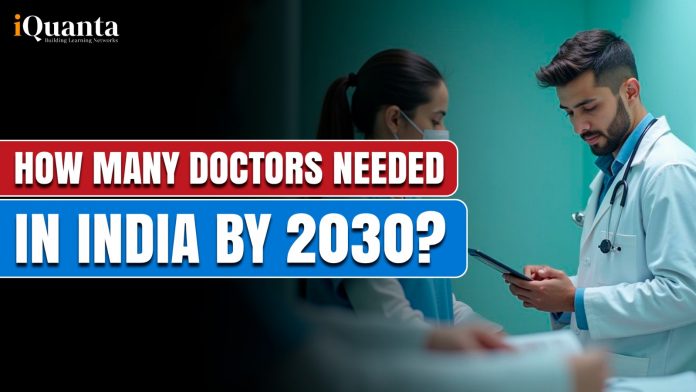India has always faced a shortage of doctors and healthcare professionals due to its growing population. As per the study in the Indian Journal of Public Health reported this September, India will require 2.07 million additional doctors by 2030 to achieve a 1:1,000 doctor-to-population ratio. The National Eligibility cum Entrance Test (NEET Exam) plays an important role in ensuring that only deserving candidates get the chance to secure a seat in the medical college. In this article, we have discussed the importance of NEET, MBBS career scope in India, and a preparation guide to help candidates achieve their dreams of pursuing their careers in the medical field.

Will Doctors be in Demand in 2030?
As per the World Health Organization (WHO) and the Ministry of Health, seven doctors are available for every 10,000 people in India. However, a research study reported that only 4.8 doctors were there for every 10,000 people in India in 2014. These findings also state that there is less possibility to achieve a decent goal of one doctor for every 1,000 people by 2030 even if the number of doctors increases. By then, the population is expected to be 1.476 billion. However, going by the research published in the Indian Journal of Public Health, it is reported that India requires 2.07 million additional doctors by 2030 to reach the 1:1,000 doctor-to-population ratio.
Why NEET Is Important to Become a Doctor
The medical profession is a highly respected yet demanding career in India. It requires hard work, skills and professional training. Thus, NEET is the only entrance exam for students seeking admission to MBBS or other medical courses. Here are a few reasons stating why NEET is important:
- NEET exam offers a fair and transparent selection process that ensures that only passionate and deserving students secure admission to medical colleges.
- NEET’s merit-based selection process reduces corruption/unfair means in medical admissions as students will be selected based on their exam performance.
- NEET adheres to a standardised syllabus that implies that students from all educational backgrounds will get an equal chance in the exam.
- NEET is a gateway to the top government and private medical colleges such as AIIMS, JIPMER, and other institutions.

About the NEET UG Exam
NEET (UG) is a qualifying entrance exam for students seeking admission to the MBBS/BDS, etc courses in AIIMS, JIPMER, and other reputed colleges. The minimum age to apply for the NEET exam is 17 years with no upper age limit. Here are the key highlights of the NEET UG exam shared below for the reference of the candidates.
| Particulars | Details |
| Exam Name | National Eligibility Cum Entrance Test (NEET) |
| Conducting Body | National Testing Agency (NTA) |
| Exam Level | National Level |
| Frequency | Once a year |
| Eligibility | 17 years, 12th pass with English, Physics, Chemistry, and Biology as the main subject |
| Mode of Exam | Offline |
| Question Type | Multiple Choice Questions (MCQs) |
| Number of Questions | 180 (45 questions each in Physics and Chemistry and 90 questions in biology) |
| Maximum Marks | 720 |
| Exam Duration | 180 minutes (3 hours) |
| Marking Scheme | +4 for each correct answer-1 for each incorrect answer0 for unattempted question |
| Official Website | neet.nta.nic.in |

How many Doctors are unemployed in India?
As per the sources, it is reported that more than 1 lakh doctors are produced from 700+ medical colleges every year. However, 1.5 lakh junior doctors are currently unemployed. It is also stated that in many cases doctors are employed on an ad hoc basis and get salaries ranging between Rs 25,000 and Rs 30,000 per month. Moreover, a good number of doctors recruited in the private sector are receiving wages on a per-day basis. To address this issue, IMA is planning to establish a national employment exchange of doctors.
What is the future of MBBS in India in 2030?
It is estimated that India will have one million extra MBBS doctors by 2030. Presently, over 1 lakh students become doctors every year. Becoming a doctor opens doors to a rewarding and fulfilling career with numerous growth opportunities. Here are the key insights about the MBBS future scope in India shared below for the reference of medical aspirants:
- The average salary of an MBBS healthcare professional is around INR 10 LPA- INR 12 LPA.
- Some high-paying job profiles for MBBS graduates are General Physicians, Chief Medical Officers, Surgeons, Paediatricians, Cardiologists, Dermatologists, etc.
- Doctors can also choose to practice medicine in their own clinics and hospitals.
- MBBS graduates can also explore research opportunities by pursuing a PhD in medicine or medical research.

NEET Preparation Tips- Gateway to MBBS
Acing the NEET exam requires the right resources, a well-organised strategy, and consistency. Thus, aspirants must build a comprehensive study plan to solidify their concepts and maximise their success chances in the medical entrance exam. Here is the step-by-step NEET preparation guide for the reference of the candidates:
- Analyse the NEET syllabus and exam pattern thoroughly and then create a subject-wise study plan. Stick to this schedule till the exam is over to maintain consistency.
- Allocate specific study slots to each subject and ensure focused preparation. Include revision and practice papers in the study plan.
- Consider the right set of NEET books to cover the concepts of all the subjects to perform well in the exam.
- Previous year’s NEET papers provide insights into the exam details, requirements and recurring topics. Regularly attempt unlimited mock tests to strengthen your preparation.
- Prepare short notes and flashcards to revise the concepts quickly and retain important fundamentals.
In conclusion, the requirements for doctors in India will rise significantly by 2030 owing to the immense population and rising disease burden. While NEET exams promote fair admissions and contribute to highly qualified doctors, the growing demand for doctors is still an issue. To reduce this gap, the government must plan to enhance medical infrastructure, increase the number of medical seats, and expand healthcare access in the country.
Join iQuanta NEET Online Course


